#Cricetus
Text

European Hamster
33 notes
·
View notes
Text
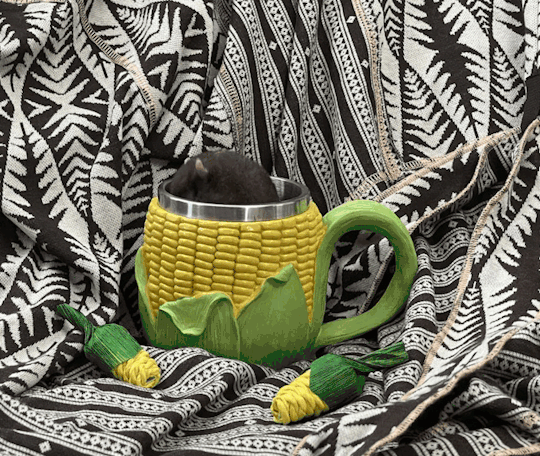
XAVIER GIF!!!
(she sleepy)
16 notes
·
View notes
Text
Animal of the Day!
European Hamster (Cricetus cricetus)
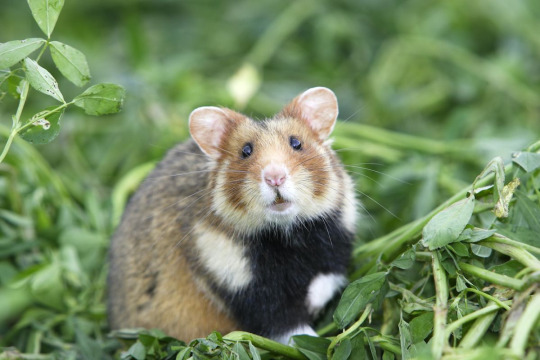
(Photo from LiveScience)
Conservation Status- Critically Endangered
Habitat- Western Europe, Russia
Size (Weight/Length)- 300 g; 25 cm
Diet- Cultivated vegetables; Fruits; Grasses; Seeds; Nuts; Small animals; Insects
Cool Facts- Despite being absolutely adorable, the European hamster is no pet. Roughly the size of a guinea pig, these hamsters are highly aggressive to fight off rival hamsters and predators as large as ferrets. European hamsters spend their days sleeping and their nights foraging. Unfortunately, these hamsters are critically endangered due to poaching for their fur, habitat destruction, and persecution by people who believe them to be agricultural pests. Captive breeding programs throughout Europe are working to increase the wild population of these delightful furballs.
Rating- 12/10 (Can carry 20% of their body weight in their cheeks)
#animal of the day#animals#rodents#hamster#tuesday#august 29#european hamster#biology#science#conservation#the more you know
443 notes
·
View notes
Text
Uncharismatic Fact of the Day
For snacking on the go, there's no better storage container than your own mouth! Hamsters are one of several different types of rodent that have evolved special pouches inside their cheeks in which to store food. At their greatest capacity, these pouches can hold up to 20% of a hamster's body weight! Aside from food, hamsters may also use their pouches to transport bedding or even their own young.
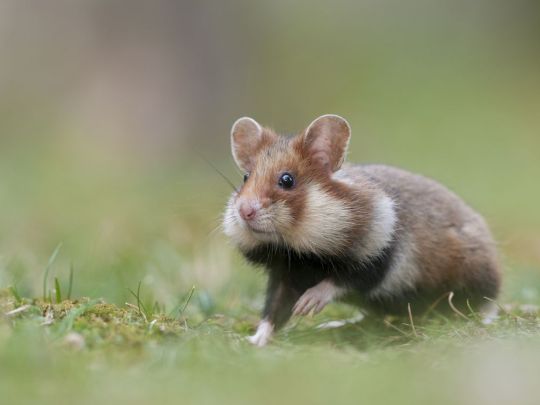
(Image: A European hamster (Cricetus cricetus) by Michaela Walch
Check out the photo under the cut to see what a hamster's pouch looks like from the inside!
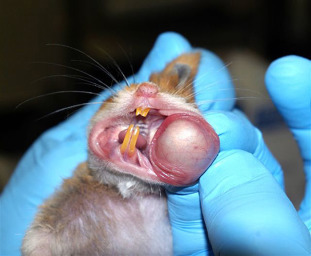
(Image: A Syrian hamster (Mesocricetus auratus) with its cheek pouch everted, by Jerald Silverman)
43 notes
·
View notes
Text
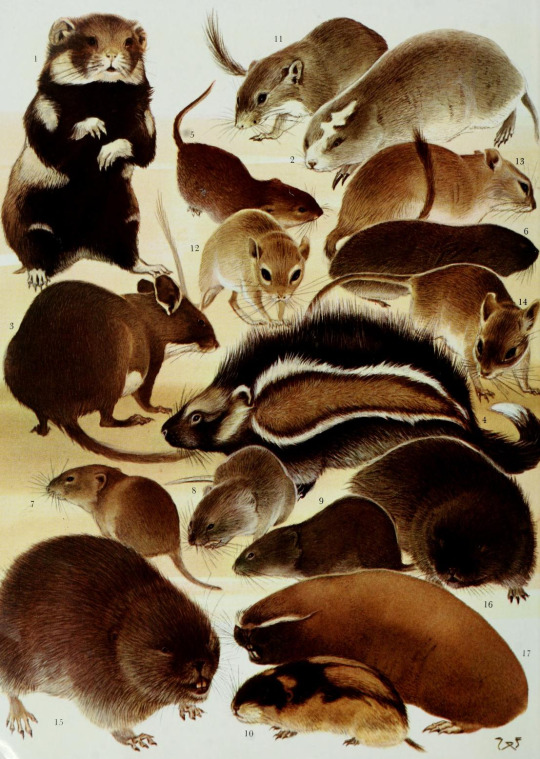
Grzimek's Animal Life Encyclopedia, vol. 11, Mammals II. 1972.
1.) European hamster (Cricetus cricetus)
2.) False zokor (Myospalax aspalax)
3.) Western nesomys (Nesomys lambertoni)
4.) Maned rat (Lophiomys imhausi)
5.) Bank vole (Myodes glareolus)
6.) Southern mole vole (Ellobius fuscocapillus)
7.) Common vole (Microtus arvalis)
8.) European snow vole or snow vole (Chionomys nivalis)
9.) Eastern meadow vole (Microtus pennsylvanicus)
10.) Norway lemming (Lemmus lemmus)
11.) Tristram's jird (Meriones tristrami)
12.) North African gerbil (Dipodillus campestris)
13.) Great gerbil (Rhombomys opimus)
14.) East African Gerbil (Gerbilliscus vicinus)
15.) Bamboo rat (Rhizomys sp.)
16.) Northeast African mole-rat (Tachyoryctes splendens)
17.) Lesser blind mole-rat (Nannospalax leucodon)
283 notes
·
View notes
Text
Wild European hamster
Cricetus cricetus, the European hamster, also known as the Eurasian hamster, black-bellied hamster or common hamster, is the only species of the genus Cricetus. It is native to grassland and similar habitats in a large part of Eurasia, extending from Belgium to the Altai mountains and Yenisey River in Russia.
The European hamster is a very aggressive animal, and in the wild each adult lives in its own burrow. They will leap at and bite any person that tries to touch it, says Mikhail Rusin, a researcher at the Kyiv Zoo in Ukraine. “Even those born in captivity, when they grow up, are not tame,” he says.
Historically, it was considered a farmland pest and had been trapped for its fur. Its population has declined drastically in recent years and is now considered critically endangered. In captivity, the European hamster has an unusually long lifespan, living up to eight years.
info source
#European hamster#hamster#wild hamster#hamsters#cute#cute hamster#cute hamsters#cute animals#nature#wild animals#fluffy
424 notes
·
View notes
Note
may i also have one of each of the hamster bitties? i want the Teddy, Cambell and Cricetus to be fullsized and i want the Roborovski to be a bara :3
i already plan to give the Teddy his own room so he knows where others shouldn't go >:3
Mantis Scythe is the one handing you your bitties this time around!
The first one is the Roborovski, one picked by Mantis herself!
His name is Azure, and he’s been returned many times by multiple different owners due to his size and his morphs, as he’s very fragile and needs a lot of care to make sure he’s the best he can be!
He uses He/Chem pronouns!
He’s 3’5”, being bigger than your average bara! He has the Glass Bones and Clockwork morphs, the glass being stained blue and the clockwork manifesting in his left leg. He needs to be cleaned twice each month!
Next is the Teddy! She’s being handed to you in a different carrier than the others due to her general dislike of other bitties!
Her name is Beverly, and she’s a bit more territorial than other Teddys for unknown reasons! Having her in her own room is very much recommended!!
She uses She/He pronouns!
She’s 2 feet tall, being an average fullsize! Her only morph is the Long Tail morph, giving her a slightly longer than average tail that can be used as an extra limb, although it’s not big enough to be moved around freely like an extra arm so she mostly uses it to hold things!
The next one you’re being handed is the Campbell! This one’s a bit of a handful to put in the carrier as he keeps nipping Mantis’s hand, but he calms down when he realizes he’s going home!
His name is Edgar and he’s incredibly sassy, often making sarcastic remarks at literally anything anyone says. Despite this, he’s also more social than other Campbells!
He enjoys baking, so make sure you get him something like an Easy Bake Oven to keep him entertained!
He uses He/Mint pronouns!
He’s 1’4” being another average fullsize! He’s got the Darker Bones and Dull morphs, making his bones a dull dark maroon!
Finally, the Cricetus! This one is the friendliest of the bunch, absolutely ecstatic to be going home!
Soft’s name is Earleen, and soft is a big fan of all things cute! Whether it be frilly clothes, pastel plushies, or generally just things that are considered adorable, soft absolutely adores them all! Soft prefers masculine clothes, though, so don’t dress soft up in any dresses!
Soft uses Soft/Softs pronouns!
Soft is 2’6”, being an average fullsize! Soft has the Hearts and Harlequin morphs, the most noticeable being the heart marking over soft’s right eye and the harlequin patterning on soft’s fur!
You’re given the carriers and some toys, along with cleaning materials for Azure! Mantis Scythe mutely waves goodbye to you as you leave with your new friends!
#bittybones#undertale#undertale au#undertale bitty#undertale fandom#bittybones au#bitty adoption#adoption#imagination4days-oldblog
2 notes
·
View notes
Note
Hey!
RETUSUS Cricetus STULTI
Um, what does that mean?
12 notes
·
View notes
Text
Deux fois plus de terriers pour le #grandhamster en #Alsace
La campagne de comptage des terriers de grand hamster réalisée au printemps en Alsace a permis d’en identifier 960, contre 488 l’année dernière. Un résultat jugé « encourageant », même si les effectifs de cricetus cricetus « restent encore fragiles et en deçà du seuil de viabilité ».
0 notes
Text
New Post has been published on WUNDERBLOG
New Post has been published on https://wunderblog.daniel-deppe.de/oelhamster-bestimmung-vorkommen-und-bekaempfung/
Ölhamster - Bestimmung, Vorkommen und Bekämpfung
Ölhamster
Der gemeine Ölhamster (Homo Cricetus Idioticus) ist ein gefährlicher parasitärer Schädling. Er verbreitet sich überall dort stark, wo die allgegenwärtigen zwangsalimentierte Lückenmedien durch das gezielte Absondern von Fehlinformationen die ohnehin extrem labilen zerebralen Neuronenverbände anfälliger Idiokraten endgültig in Kopfsalatsoße verwandeln. Der nachfolgende Beitrag will dabei helfen, Ölhamster korrekt einzuordnen, schnell und exakt zu identifizieren und, sofern möglich, nachhaltig zu vertreiben.
Ölhamster: Bestimmung
Ölhamster sind beschämend eng verwandt mit Klopapierhamstern (Cricetus Latrinariam Mutus), Nudelhamstern (Cricetus Collȳra Stupidus) oder Mehlhamstern (Cricetus Farina Asinus). Man erkennt diese intelligenzbefreiten ÖR-Propaganda-Opfer daran, dass sie ohne tatsächlichen Bedarf hektoliterweise die allerbilligsten Sorten Speiseöl aus den Geschäften schleppen. Hochpreisige Öle lässt der Ölhamster üblicher Weise in den ansonsten leergefegten Regalen stehen. Damit jene Zeitgenossen, die wirklich mal etwas Öl für die heimische Küche brauchen, obszön tief in die Tasche greifen müssen. Findet man einen Ölhamster in seinem Habitat vor, so lassen sich in dessen Vorratslager Unmengen an gebunkertem Speiseöl antreffen. So viel Öl, dass sämtliche belgischen Frittenbuden zusammen auch unter Bewirtungs-Vollast 100 Jahre bestens damit wirtschaften könnten.
Ölhamster: Vorkommen
Diese widerwärtigen, asozialen und belehrungsresistenten Abkömmlinge einer herzlosen und wohlstandsverwahrlosten Ellenbogengesellschaft finden sich derzeit endemisch in Deutschland. Zahlreichen Berichten zufolge werden diese Schädlinge im Ausland milde belächelt bis schallend ausgelacht. Und es wird gesagt, dass derzeit bereits Wetten darüber abgeschlossen werden, wann die nächste Mutation ihr hässliches Haupt in den Supermärkten erhebt. Beispielsweise der Wattestäbchenhamster, der Erbsenhamster oder der Schuhputzcremehamster, um nur drei von unendlich vielen deutschen Denkfiguren zu nennen. Obwohl (Achtung Insidertipp!) bereits gemunkelt wird, dass demnächst geschälte Tomaten in Dosen und Frischfleisch in den Lebensmittelgeschäften nicht mehr zu bekommen sein werden.
Ölhamster: Bekämpfung
Den Ölhamster selbst kann man nicht ausrotten. Diese Plage ist zu mächtig, um sie samt der Wurzel allen Übels komplett ausreißen zu können. Mit Giftködern geht leider auch nichts, denn gegen so viel Blödheit bleibt auch das stärkste Gift wirkungslos. Bei Dummheit helfen eben keine Pillen. Das einzige Mittel, das Erfolg verspricht, ist die Vergrämung von Ölhamstern. Dazu muss der Händler lediglich das Objekt bzw. die Objekte der Begierde konsequent aus dem Sortiment nehmen. Wer kein Öl mehr führt, gar kein Öl mehr (nein, das ganz Teure auch nicht), den werden diese Schädlinge bald nicht mehr belästigen. Die andere Möglichkeit, Öl zu Freudenhauspreisen anzubieten, hat sich in der Praxis als Schuss in den Ofen erwiesen. Denn dann versuchen die Ölhamster, die Ware kackendreist zu stehlen. Oder sie schicken ihre minderjährige Brut zum Ölklau in den Markt. So oder so will man mit dieser Art der Kriminalität als Marktleiter nichts zu tun haben. Merke: Bleiben die Regale leer, kommen auch die Ölhamster nicht mehr.
Fazit
Spätestens seit Wild Hogs wissen wir, dass Bären keine Scheiße fressen. Doch was wäre, wenn man dem deutschen Homo Fatuum durch die Kanäle des deutschen Staatspropagandafunks erzählen würde, dass Scheiße demnächst knapp wird? Würden die Ölhamster dann zu Scheißhamstern mutieren? Ausschließen kann man das leider nicht
– Milla Münchhausen –
Das Beitragsbild / Symbolfoto (das Originial ist ohne Öl ) wurde von Melissa Keizer auf Unsplash zur Verfügung gestellt. Hiermit wird der abgebildete supersüße Hamster ausdrücklich dafür um Verzeihung gebeten, durch die Fotomontage in die Nähe des gemeinen Ölhamsters gerückt worden zu sein.
0 notes
Text

Squirrel (Sciurus) & Hamster (Cricetus), Dictionnaire Universel D'histoire Naturelle (1892) - Charles Dessalines D’Orbigny
#Wonder Rooms#Cabinet of Curiosities#Public Domain#19th Century#Charles Dessalines D’ Orbigny#Dictionnaire Universel D'histoire Naturelle#Scientific Illustration#Natural History#Zoology#Animalia#Mammalia#Rodentia#Sciuridae#Sciurus#Cricetidae#Cricetus
28 notes
·
View notes
Photo

mig
12 notes
·
View notes
Photo

“Ellie. <3″ by Elena B. on Flickr
12 notes
·
View notes
Text

the biggest european colony of eurasian hamster// cricetuscricetus right next to my tiny flat. what a luck to have them in the city of vienna.
2 notes
·
View notes
Text
OMG WHY DO I ONLY HEAR ABOUT THE NATIVE WILD EUROPEAN HAMSTER NOW?
"The European hamster (Cricetus cricetus), also known as the Eurasian hamster, black-bellied hamster or common hamster, is the only species of the genus Cricetus. It is native to grassland and similar habitats in a large part of Eurasia, extending from Belgium to the Altai mountains and Yenisey River in Russia. Where abundant the animal is considered a farmland pest, and historically it has also been trapped for its fur. It has declined drastically in recent years and is considered critically endangered."
WHY DID I NOT KNOW THERE WAS A NATIVE HAMSTER IN BELGIUM? WHY IS IT CALLED ´WOLF OF THE CORN´ IN DUTCH WHICH IS BADASS? WHY IS IT CRITICALLY ENDANGERED AND IS NO ONE TALKING ABOUT IT? IS ANYONE SAVING THEM? LOOK AT THEM I LOVE THEM!
Why is europe losing its hamsters😭?

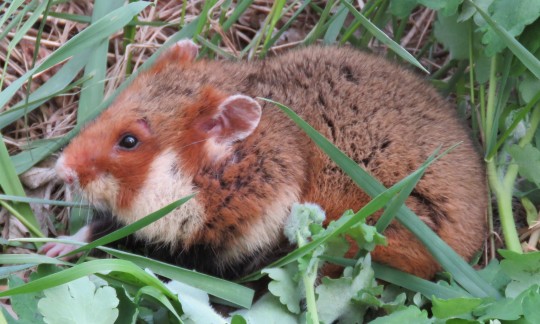


Look at those coloured cheeks? And its black belly! Perfection!
#hamster#endangered#european hamster#zoology#naturecore#nature#rodent#korenwolf#conservation#wildlife#save our hamster
87 notes
·
View notes
Photo
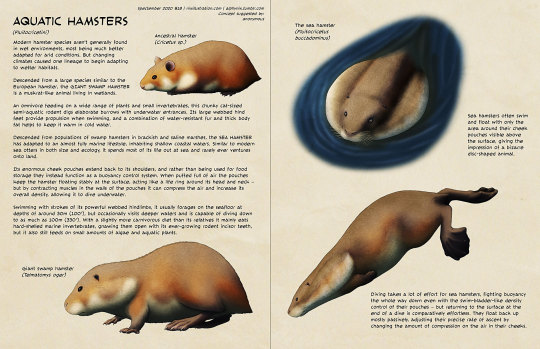
Transcript for the text on the image under the cut:
PAGE 1
Spectember 2020 #18 | nixillustration.com | alphynix.tumblr.com
Concept suggested by:
anonymous
Aquatic Hamsters
(Fluitocricetini)
Modern hamster species aren't generally found in wet environments, most being much better adapted for arid conditions. But changing climates caused one lineage to begin adapting to wetter habitats.
Descended from a large species similar to the European hamster, the GIANT SWAMP HAMSTER is a muskrat-like animal living in wetlands.
An omnivore feeding on a wide range of plants and small invertebrates, this chunky cat-sized semi-aquatic rodent digs elaborate burrows with underwater entrances. Its large webbed hind feet provide propulsion when swimming, and a combination of water-resistant fur and thick body fat helps to keep it warm in cold water.
Descended from populations of swamp hamsters in brackish and saline marshes, the SEA HAMSTER has adapted to an almost fully marine lifestyle, inhabiting shallow coastal waters. Similar to modern sea otters in both size and ecology, it spends most of its life out at sea and rarely ever ventures onto land.
Its enormous cheek pouches extend back to its shoulders, and rather than being used for food storage they instead function as a buoyancy control system. When puffed full of air the pouches keep the hamster floating stably at the surface, acting like a life ring around its head and neck – but by contracting muscles in the walls of the pouches it can compress the air and increase its overall density, allowing it to dive underwater.
Swimming with strokes of its powerful webbed hindlimbs, it usually forages on the seafloor at depths of around 30m (100’), but occasionally visits deeper waters and is capable of diving down to as much as 100m (330’). With a slightly more carnivorous diet than its relatives it mainly eats hard-shelled marine invertebrates, gnawing them open with its ever-growing rodent incisor teeth, but it also still feeds on small amounts of algae and aquatic plants.
[Image: a typical hamster, a small chubby rodent with rounded ears, short legs, and a stubby tail.]
Ancestral hamster (Cricetus sp.)
[Image: a muskrat-like semi-aquatic hamster, with small ears, webbed digits, and large back feet.]
Giant swamp hamster (Telmatomys oger)
PAGE 2
[Image: a marine hamster swimming at the surface, with only the top of its head and its huge inflated cheek pouches actually visible.]
The sea hamster (Fluitocricetus buccadominus)
Sea hamsters often swim and float with only the area around their cheek pouches visible above the surface, giving the impression of a bizarre disc-shaped animal.
[Image: an otter-like marine hamster swimming downwards. It has huge inflated cheek pouches extending to its shoulders, and large webbed hind feet that it uses to propel itself underwater.]
Diving takes a lot of effort for sea hamsters, fighting buoyancy the whole way down even with the swim-bladder-like density control of their pouches – but returning to the surface at the end of a dive is comparatively effortless. They float back up mostly passively, adjusting their precise rate of ascent by changing the amount of compression on the air in their cheeks.
#spectember 2020#spectember#speculative evolution#specevo#aquatic hamsters#giant swamp hamster#sea hamster#science illustration#art#not paleoart#last aquatic one this month#i just got a lot of suggestions about swimmy things
257 notes
·
View notes